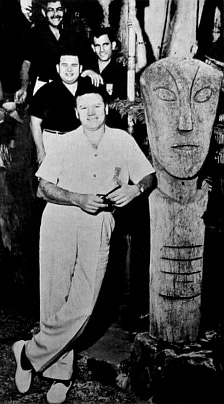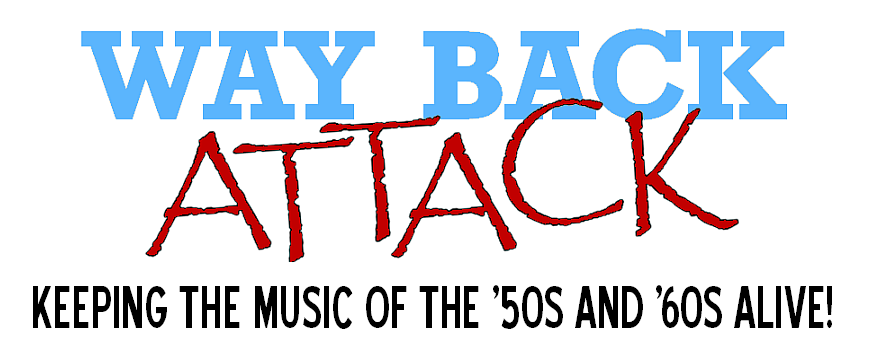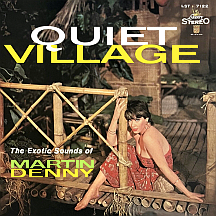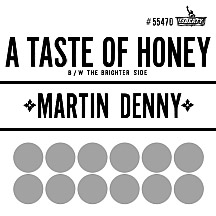MARTIN DENNY
Quiet Village
In the 1950s, the "world village" took a few more steps towards bringing people of far-flung regions and differing musical cultures closer together. The "exotica" craze of the late '50s isn't what you'd call "world music," as its practitioners openly admitted to taking traditional instruments and combining the sounds in experimental ways, thus creating music reminiscent of, but not necessarily true to, the styles and rhythms of Africa, the Orient, the Caribbean and other points on the globe. In 1951, Les Baxter recorded Ritual of the Savage, a "tone poem" of jungle sounds (a year after he'd orchestrated Voice of the Xtabay, the debut album by Peruvian singer Yma Sumac, in a similar style). These were forerunners of the trend, although the operative pop culture term didn't come into use until 1957 with the release of Martin Denny's album Exotica.
A native of New York City, Denny studied classical piano during high school. In his early twenties, he spent four years (1931 through 1935) touring South America (primarily Colombia, Argentina and Chile) with a group of five other jazz musicians from Los Angeles, performing covers (a term that didn't yet exist) of the top hits of the day. After serving in the U.S. Army Air Force during World War II, he studied at the Los Angeles Conservatory of Music and was a touring pianist for many bands during the 1940s; a '49 run backing Betty Hutton was followed by a yearlong stint with "the incomparable" Hildegarde. He became fascinated with jazz pianist George Shearing, who incorporated the vibraphone (played by Margie Hyams) as a major component of his late-'40s sound. In 1954, Donn Beach (owner of "tiki bar" Don the Beachcomber in Hollywood, California) gave Martin an opportunity to perform for six months at the Dagger Bar, located on the beach at Waikiki in Oahu, Hawaii.
Hooked by the Pacific Island lifestyle, he later formed a trio (with bassist John Kramer and Kauai-born vibraphonist Arthur Lyman) that gigged regularly in the Surf Room at the Royal Hawaiian Hotel. They were basically a jazz band (with little or no island influence), but during a later residency at Henry J. Kaiser's Hawaiian Village Hotel, Martin added a fourth member, bongo player Augie Colon, whose technique gave the act a Latin flavor (very popular in the mid-'50s "mambo" era). Augie was a big fan of Les Baxter's work and soon the quartet began experimenting with different sounds, occasionally using instruments from foreign countries. A highlight of their show was "Quiet Village" (a track from Baxter's Ritual LP), with various sound effects added; Denny claimed the frogs in the club's open-air pond would join in with on-cue croaks! By the time they'd incorporated bird calls into the number, it had become their most-requested song among club patrons; popular demand dictated they play the song several times per night.
Gradually the show became more theatric as they did "snake charmer" routines while Augie sported a turban and new instruments were regularly added to the act. Some of these included the three-stringed Japanese samisen, wooden-stringed koto and glass wind chimes (creating a tinkling sound that, according to legend, wards off evil spirits) as well as chimes of the bamboo or hollow steel variety, a marimbula (or West Indies pluck-box), m'bira (African thumb piano) and Buddhist gongs, cymbals and prayer bells in addition to the celestette (a miniature celeste), a four-hand marimba, a steel drum, a 200-pound log from New Guinea, the more modern boo-bams (bamboo-and-skin percussion instruments) and a local favorite, the ipo (a Hawaiian gourd). At one point, airline pilots and stewardesses were donating unusual instruments they found in their travels. There was no chance Denny's band would be able to play some of these in the way ancient originators may have intended, so they simply came up with combinations that appealed to them. It gave a whole new meaning to the "tropical music" concept and people from all walks of life (tourists from five continents and many military personnel) came to soak up the experience.
While headlining at Kaiser's Shell Bar on Waikiki, their manager got them a contract with Liberty Records. Denny's debut 12-track instrumental album, Exotica, was recorded in a single session in October 1956. "Hong Kong Blues" (a remake of a Hoagy Carmichael song from Howard Hawks' 1944 film To Have and Have Not starring Humphrey Bogart), was issued as the first single. Harvey Ragsdale had long since replaced Kramer on bass and also mastered the marimbula. The album's initial success (it reached the top 20 of Cash Box magazine's album chart in the fall of '57) was enough reason for Denny to return to the States, but Lyman chose to stay in Hawaii and started his own group that became the Shell Bar's regular band. Denny took a chance on an up-and-coming vibes player, 22-year-old Julius Wechter who, with Colon and Ragsdale, were the main players on record and in concert for several years. Liberty president Sy Waronker began using the word "exotica" to describe not just the album but the entire genre of foreign-based instrumental music...and it caught on.
More longplays followed in quick succession: Exotica Volume II, Forbidden Island and Primitiva, all in 1958. Near the end of the year, Waronker had the quartet re-record Exotica in the recently-implement two-channel process he called "Spectra-Sonic Sound." Signature song "Quiet Village" was sent out as a single, which meant bird calls and jungle noises became an hourly part of the rapidly-expanding top 40 format that was wildly successful in nearly every radio market. The single spent most of May and June 1959 in the top ten while the second-time-around album topped the charts for several weeks that summer (both stereo and mono LPs were selling like poi-battered hotcakes!); the re-release had been well-timed to take advantage of the public's fascination with the soon-to-be 50th state.
Sandy Warner, an actress and model, was another part of the success of Exotica and its many offspring. Hired by Waronker to grace the covers, he dubbed her "The Exotica Girl," though Denny only met her once, when she attended one his Hawaiian shows. In 1959, after several cover appearances, she recorded a vocal album for Tops Records, Fair & Warner (under the heading "Steve Allen presents Sandy Warner"). Denny wrote the album's liner notes, commenting on her beauty: "...it was a standing gag among most D.J.s that they were unaware there was a record in the album until some time later."

"Martinique" and "The Enchanted Sea" were chart singles later in 1959, the latter a top 30 cover of an original on the Mayflower label by The Islanders (consisting of guitarist Randy Starr and accordionist Frank Metis) that reached the top 20 a few weeks ahead of Denny. Albums that year, all with cover photos of Sandy, were Hypnotique, Afro-Desia, Exotica Volume III and a Quiet Village LP (or: second attempt to milk the hit single), which joined Exotica in the top ten of the album charts that fall.
Reviewers were generally positive and celebrities supplied liner notes for Denny's albums. Les Baxter referred to Primitiva as "a ballet of motion" and pointed out that Martin even used children's toy bells he'd bought in a five-and-dime store. Author James Michener (his sixth novel, Hawaii, was a best seller at the time) said Denny was "...careful to provide in his orchestrations the specific sound of things banging into other things, or scraping across them, or being struck by a human hand." And on the Quiet Village LP, film director John Sturges (a Best Director Oscar nominee for 1955's Bad Day at Black Rock starring Spencer Tracy) called Martin "a great big husky guy who looks like he could make bow knots out of iron bars" and revealed the existence of "...a horde of these Waikiki prophets" who'd predicted "...a smash success on the first listen."
Meanwhile, back in Hawaii, Lyman continued to pack in the crowds, implementing a near-identical sound and presentation to what he'd done in those formative Waikiki days. His HiFi label album Taboo, released after Denny's first four LPs, had actually made the top ten in sales in late '58, several months before Exotica established Denny as an even bigger star. This created a professional rivalry between the former bandmates, though one that didn't affect their lifelong friendship. There was plenty of room for two (or more!) popular island-music acts. Denny had occasional luck on singles, but his string of albums, eventually numbering more than three dozen, was what his core audience (many of them hi-fi/stereo enthusiasts) clamored for. Early 1960s albums furthered the unusual-instrument ploy; there were a few Exotic Sounds... volumes and one called Romantica, then the sound evolved as he went into a more jazz-oriented phase. "A Taste of Honey," a top 50 single and top ten album in 1962, showed off Martin's fluent piano skills while becoming the first of several popular (mostly-instrumental, sometime-vocal) versions of the brilliant 1960 composition by Bobby Scott and Ric Marlowe.
Wechter left after about five years with the group, forming The Baja Marimba Band, a successful south-of-the-border act on Herb Alpert's A&M label. His replacement on vibraphone was Hagood Hardy (who'd previously performed with jazz flutist Herbie Mann). By the mid-'60s (as Liberty continued releasing an average of two to three LPs per year), the sound was no longer identifiable as Denny's; he later admitted he'd had nothing to do with certain projects, but was still paid full royalties (under the terms of his contract) for the use of his name. Martin Denny lived to the age of 93, long enough to bask in the recognition of his work during the 1990s exotica/space age/bachelor pad music revival, credited as one of the originators of a notable musical trend that had been incredibly popular four decades earlier.



